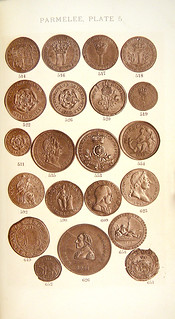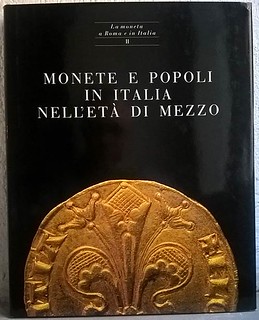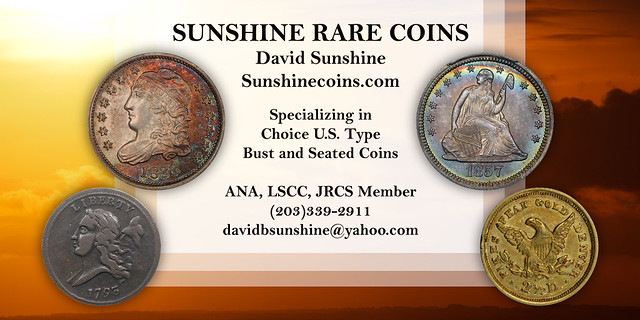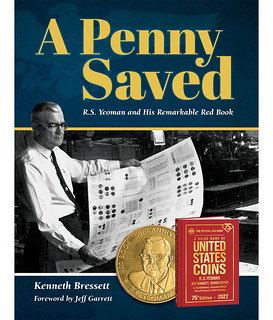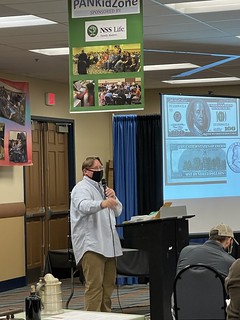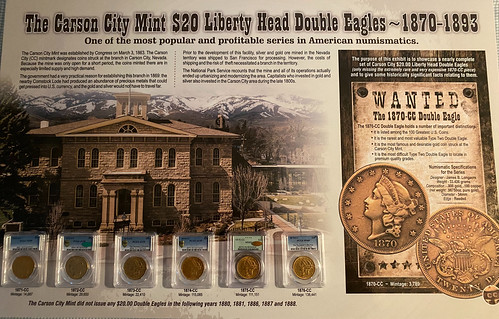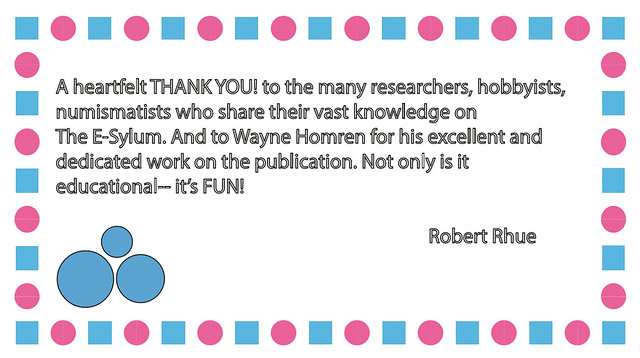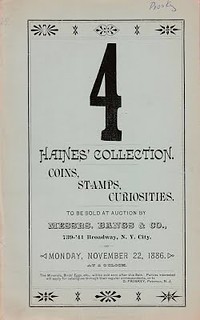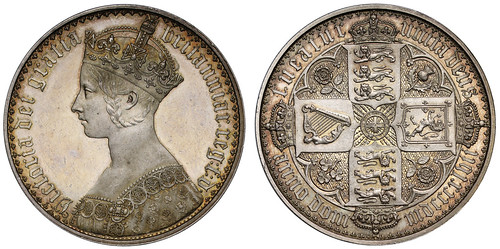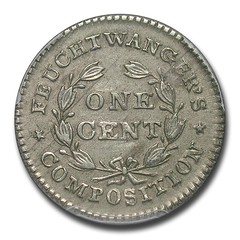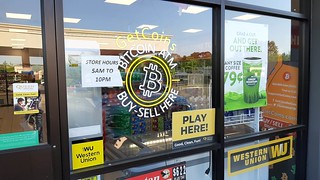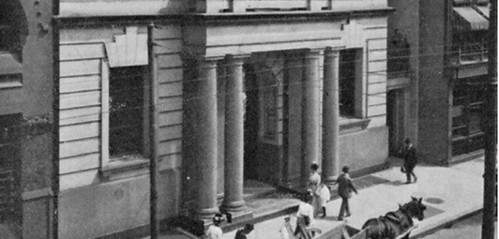
Visit our NBS Sponsors


About UsThe Numismatic Bibliomania Society is a non-profit association devoted to the study and enjoyment of numismatic literature. For more information please see our web site at coinbooks.org SubscriptionsThose wishing to become new E-Sylum subscribers (or wishing to Unsubscribe) can go to the following web page link MembershipThere is a membership application available on the web site Membership Application To join, print the application and return it with your check to the address printed on the application. Print/Digital membership is $40 to addresses in the U.S., and $60 elsewhere. A digital-only membership is available for $25. For those without web access, write to: Charles Heck, Treasurer AsylumFor Asylum mailing address changes and other membership questions, contact Chuck at this email address: treasurer@coinbooks.org SubmissionsTo submit items for publication in The E-Sylum, write to the Editor at this address: whomren@gmail.com BUY THE BOOK BEFORE THE COINSale Calendar |
- WAYNE'S WORDS: THE E-SYLUM MAY 16, 2021
- KOLBE & FANNING AUCTION SALE 160 REMINDER
- JUNE 2021 BERTOLAMI LITERATURE E-AUCTION
- NEW BOOK: MICHIGAN MINING SCRIP
- AN EDITOR'S APPRECIATION FOR A PENNY SAVED
- NNP: JOHN FROST SPEAKS ON 20-CENT PIECES
- VIDEO: "FOXY" STEINBERG INTERVIEW
- COIN WORLD ON INFLUENCE IN NUMISMATICS
- NOTES FROM E-SYLUM READERS: MAY 16, 2021
- PAN 2021 SPRING SHOW A BLOCKBUSTER
- VOCABULARY TERM: EDGE LETTERING, PART 1
- MORE ON DAVID ULYSSES PROSKEY (1853-1928)
- DENIS LORING RECEIVES EAC'S SILBERMAN AWARD
- ARTICLE HIGHLIGHTS AUTHOR ED FUHRMAN
- PAN CLARION INTERVIEWS LIANNA SPURRIER
- M.S. RAU LAUNCHES NUMISMATICS DIVISION
- DAVE & ADAM'S ENTERS NUMISMATICS
- TARGET HALTS SALES OF TRADING CARDS
- SOVEREIGN RARITIES AUCTION 4 PREVIEW
- 2021 ANA WORLDS FAIR OF MONEY EXHIBITS
- INTERNATIONAL TOKEN WEB CONFERENCE
- JEWISH AMERICAN HERITAGE MONTH TALKS
- NUMISMATIC NUGGETS: MAY 16, 2021
- ROMAN PRAETORIAN GUARD COINS FOUND
- WHAT ANCIENT COINS TELL US
- MARY BEARD FUNDS CLASSICS SCHOLARSHIPS
- GOLD BRACTEATES FOUND IN NORWAY
- THE 1969-S DOUBLED DIE CENT
- THE NEW COIN SHORTAGE OF 2021
- TREASURY SECRETARY OFFICE CURRENCY DISPLAYS
- THEORY: CURRENCY "PREDICTED" COVID PANDEMIC
- BITCOIN ATMS APPEARING
- HYBRID CRYPTO-BANKNOTES PROPOSED
- LOOSE CHANGE: MAY 16, 2021
- FEATURED WEB SITE: CUBAN NUMISMATIC ASSOCIATION
Click here to read the thin version on the web
Click here to subscribe
Click here to access the complete archive
To comment or submit articles, reply to whomren@gmail.com
Content presented in The E-Sylum is not necessarily researched or independently fact-checked, and views expressed do not necessarily represent those of the Numismatic Bibliomania Society.
WAYNE'S WORDS: THE E-SYLUM MAY 16, 2021
 New subscribers this week include:
Nicolas Gimbert, courtesy of Martin Kaplan;
Franklin Nussbaum, courtesy Laurence Edwards;
Julie Salmon, courtesy Chris Salmon; and
Grant Hammersberg.
Welcome aboard! We now have 6,641 subscribers.
New subscribers this week include:
Nicolas Gimbert, courtesy of Martin Kaplan;
Franklin Nussbaum, courtesy Laurence Edwards;
Julie Salmon, courtesy Chris Salmon; and
Grant Hammersberg.
Welcome aboard! We now have 6,641 subscribers.
Thank you for reading The E-Sylum. If you enjoy it, please send me the email addresses of friends you think may enjoy it as well and I'll send them a subscription. Contact me at whomren@gmail.com anytime regarding your subscription, or questions, comments or suggestions about our content.
This week we open with two numismatic literature sales, a new book, an update from the Newman Numismatic Portal, and more.
Other topics this week include 20-cent pieces, the PAN show, edge lettering, Denis Loring, Ed Fuhrman, Lianna Spurrier, new enterants in the numismatic market, ANA exhibits, online numismatic fora, ancient coins, the 1969-S doubled die cent, a circumcision medal, BitCoin ATMs, and hybrid crypto-banknotes.
To learn more about Michigan Mining Scrip, Richard S. Yeo, David Proskey, influence in numismatics, Guadalupe's Basilica, coin boards, the Victoria Proof Gothic Crown, Victor David Brenner, Secretary Yellen's currency displays, and the squirting nickel, read on. Have a great week, everyone!
Wayne Homren
Editor, The E-Sylum
KOLBE & FANNING AUCTION SALE 160 REMINDER
Here's a final reminder of this week's Kolbe & Fanning numismatic literature sale, along with another great group of highlights. There's important material here - review the catalog carefully. -Editor
MAY 22 KOLBE & FANNING AUCTION REMINDER
Kolbe & Fanning Numismatic Booksellers are holding our Sale 160 on this Saturday, May 22, 2021. Featuring additional material from the library of Richard Margolis, along with properties belonging to several other consignors, the 459-lot auction offers books, catalogues and periodicals covering the gamut of numismatic topics, from antiquarian volumes to standard current works.
Some highlights of the sale include:
Lot 11: a bound volume reproducing the photographic record of the L. Biaggi Blasys collection of Roman gold coins and medallions
Lot 117: a nearly complete set of Svoronos's rare Journal international d'archéologie numismatique, featuring many specialized monographs on ancient coins
Lot 187: a complete 102-year run of the Journal of the Canadian Bankers' Association, 1893–1995, featuring many articles of numismatic relevance
Lot 237: the important 1908–1911 series of Adolph Hess auctions of the Sammlung Erbstein, complete with all plates and prices realized lists
Lot 302: Charles Saunier's essential biographical study of Augustin Dupré, the exceptional French medalist and coin engraver
Lot 340: a unique file on United States pattern coins from the library of Wayte Raymond, with material by Edgar H. Adams, Lenox R. Lohr, and others
Lot 386: a very scare and unusual printing of the first Pocket Edition of Heath's Infallible Counterfeit Detector at Sight, Newman 1-P-20
Lot 390: the exceptionally rare 1859 edition of Hodges' Genuine Bank Notes of America, lacking from the Fuld, Champa and Bass Libraries
Lot 408: a nearly complete set of catalogues issued by the New Netherlands Coin Company, with most of the early catalogues being unusually well-preserved
Lot 410: a priced and named copy, with all 13 fine tinted plates, of the New York Coin & Stamp Company's important 1890 sale of the Lorin G. Parmelee collection.
Bids may be placed via post, email, fax or phone, as well as online. Kolbe & Fanning use Auction Mobility as our third-party online bidding platform. Auction Mobility is an app-based platform allowing users the ability to participate in the sale through phones, tablets and computers. To register for the sale, bidders must go to bid.numislit.com and sign up. Once you have set up an account, you may browse lots, place advance bids, or participate in the live sale online. Those wishing to participate on their devices can download the Kolbe & Fanning app through the Apple or Google Play Store.
The printed catalogue of Sale 160 has been mailed to all active customers on our mailing list. As international mail speeds remain somewhat slowed by the Corona situation, we encourage our international clients to consult the electronic catalogue in case their printed catalogue does not arrive promptly. A PDF of the printed catalogue has been posted to our main website at numislit.com for those who prefer that format. Bids placed via post, email, fax or phone must be received by May 21, the day before the sale, in order for them to be processed. Advance absentee bids may also be placed at any time online at bid.numislit.com. Live internet bidding will be available during the sale itself through the same platform. The sale is also listed on Biddr and NumisBids.
Kolbe & Fanning Numismatic Booksellers LLC is a licensed and bonded auction firm in the State of Ohio. For more information, please see the Kolbe & Fanning website at numislit.com or email David Fanning at df@numislit.com. To register for the sale, go to bid.numislit.com We look forward to your participation.
To read the earlier E-Sylum articles, see:
KOLBE & FANNING AUCTION SALE 160 ANNOUNCED
(https://www.coinbooks.org/v24/esylum_v24n18a02.html)
KOLBE & FANNING AUCTION SALE 160 HIGHLIGHTS
(https://www.coinbooks.org/v24/esylum_v24n19a03.html)
JUNE 2021 BERTOLAMI LITERATURE E-AUCTION
The June 2021 Bertolami Fine Arts E-Auction 100 includes over 300 lots of numismatic literature. Here are some selections. -Editor
Lot 1862: AMBROSOLI S. - Museo provinciale di Catanzaro. Catalogo della collezione numismatica. Monete medioevali e moderne, medaglie, ecc. Catanzaro, 1891. pp. 226, lotti 612+297+89+15. Raro
Lot 1890: ASCANI O. - CARPENZANO G. - L'oro e la legge. Commercio, esportazione, importazione, aspetti amministrativi, tributari, valutari. Milano, 1982. Pp. 443, 12 tavv. Col
Lot 1892: BALBI DE CARO S. - Monete e popoli in Italia nell'età di mezzo. Milano, 1993. pp. 239, molte ill. e ingrandimenti colore, Manca la sopraccoperta
Lot 1903: Bendall S. - Byzantine Weights. An Introduction. The Lennox Gallery, London 1996 ( Reprint London Ancient Coins ltd, 2020). Brossura editoriale, pp. 68,numerose illustrazioni in b/n, Nuovo
Lot 1944: CARSON R. A. G. - Coins ancient, medieval, modern. London, 1966. pp. 642, tavv. 64
Lot 1960: CORPUS NUMMORUM ITALICORUM. Vol. 12: Toscana. Firenze. Bologna, 1972. Ristampa anastatica dell'edizione originale di Roma, 1910-1943
Lot 2021: MAZARD J. - Histoire monetaire et numismatique contemporane. Paris-Bâle, 1965-1969. 2 voll. Tome I: 297pp.; b/w ill.; Tome II: 313pp., b/w ill
Lot 2041: Nascia Giuseppe, Appunti di numismatica editi per il ventennale dell'Ars et Nummus, Ed. Pubblifer, Saronno s. d. Brossura editoriale, 133pp, riccamente illustrato. Opera stampata in 600 esemplari numerati, questa è la n. 313. Timbro araldico a secco della ditta Ars et Nummus al frontespizio. Ottima copia.
For more information, or to bid, see:
NUMISMATIC BOOKS - WEB AUCTION 100
(https://auctions.bertolamifinearts.com/en/cat/294/148/numismatic-books/1/)
NEW BOOK: MICHIGAN MINING SCRIP
John and Nancy Wilson submitted this article about a new book on Michigan Mining Scrip. Thanks! -Editor
MICHIGAN MINING SCRIP, Paper of the Northern Michigan Copper and Iron Mining
Districts,
by Judith Haskins Davis, David H. Gelwicks and Chester L. Krause, 2021
 Published by: David H. Gelwicks Publishing, Monroe, Michigan,
michiganscrip@gmail.com
Published by: David H. Gelwicks Publishing, Monroe, Michigan,
michiganscrip@gmail.com
Reviewed by: John and Nancy Wilson, NLG
This wonderful and well-done reference has been in production for many years and was originally started by collector and publisher Chester Krause (1923-2016) who collaborated with Copper Harbor, Michigan historian and collector Judy Davis. About ten years later Michigan Tech Alumnus Dave Gelwicks, joined the project to bring this reference to completion. Mr. Gelwicks dedicates the reference to Judy Davis and in memory of Chet Krause. On one of the pages Clifford Mishler does an "In Memory of Chet" and quoting him, Personally, I'm particularly delighted to see this land-breaking and comprehensive study embracing the consequential 19th century scrip issues from Michigan's Upper Peninsula come to fruition.
Michigan Mining Scrip, Paper of the Northern Michigan Copper and Iron Mining Districts comes with a very important rarity scale. It is a Hard Bound 320-page reference of mining notes, scrip, maps and much more. Behind the front and inside the back covers you will find maps of Michigan, which will help the reader find the location of material contained in the reference. Only 500 numbered copies were made. It is fully illustrated with more than 550 notes and figures shown in the book. You will also find hundreds of color images.
The three parts are Part 1 - Copper Mines - covers 180 pages, Part 2 - Iron Mines - covers 72 pages and Part 3 – Miscellaneous - covers 26 pages. The period represented in the reference covers a span from 1824 to 1963. The reference includes obsolete bank & scrip notes, sight & after date drafts, checks, post cards, bearer notes, national bank notes, coupons, receipts, letters, various types of certificates including stock, and other types of fiscal related items. The reference has a description of scrip, checks, sight drafts and bearer notes. Just about every item listed in this book should be considered scarce to rare with some unique. If you ever wondered why parts of Wisconsin were part of Michigan, several pages explaining Cessation and Statehood explain how that happened, along with other pertinent information on Michigan statehood. The Bibliography will help researchers and everyone else who might be looking for information on Mining Scrip.
 The book contains many great notes and the stories that brought them into
circulation. We especially liked the unique American Fur Company coupon dated 1824 from Michilimackinac County, Michigan Territory. Other items of special interest are the Keweenaw County, Delaware Mining Company, along with Quincy Mining certificates, many of which are signed by Samuel Hill. Samuel W. Hill was an American surveyor, mining developer and geologist in Michigan's copper mines. He was famous for some slang words he used, one of which is,
The book contains many great notes and the stories that brought them into
circulation. We especially liked the unique American Fur Company coupon dated 1824 from Michilimackinac County, Michigan Territory. Other items of special interest are the Keweenaw County, Delaware Mining Company, along with Quincy Mining certificates, many of which are signed by Samuel Hill. Samuel W. Hill was an American surveyor, mining developer and geologist in Michigan's copper mines. He was famous for some slang words he used, one of which is, What the Sam Hill.
When he was alive radio personality Rush Limbaugh used What the Sam Hill,
on occasions. We have several versions of notes with his signature on them, some of which were given to us by Dealer Larry Falater, from Michigan.
It was a lifetime of work by Mr. Gelwicks who spent countless years assembling the collection, along with the mind-boggling research involved in bringing this reference to completion. Past publications, of this type simply documented notes that were currently known.
This reference goes the extra mile providing accurate and precise information and data on every known Mining
note or ephemera item. David Gelwicks is well known for his outstanding and award-winning exhibits. He completed the work started by co-authors Judith Haskins Davis and Chester L. Krause (1923 – 2016). We think you will enjoy reading this well-done and comprehensive reference on Michigan Mining Scrip.
David Gelwicks now brings to you a reference of Michigan Mining Scrip that you will find, historical, educational, informative, interesting and entertaining. We think it should be in every collector, dealer or historian's library. Books can be ordered via email to Michiganscrip@gmail.com Send a check payable to Dave Gelwicks, PO Box 2596 Monroe, MI 48161 in the amount of $55 which includes media mail.
AN EDITOR'S APPRECIATION FOR A PENNY SAVED
Dennis Tucker of Whitman Publishing passed along this article by Barbara Gregory about her work on the new book by Ken Bressett on R.S. Yeoman and the Red Book. Thanks! -Editor
The latest Whitman Publishing book by Kenneth Bressett will debut in summer 2021. A Penny Saved: R.S. Yeoman and His Remarkable Red Book celebrates the life of Bressett's mentor, hobby legend Richard S. Yeo (known as R.S. Yeoman), and the longevity of his Guide Book of United States Coins (the Red Book
), first published in 1946. The 352-page hardcover volume will be available from bookstores and hobby shops and online (including at Whitman.com), and in the meantime is available for preorder. Here, Barbara J. Gregory, who assisted Bressett on A Penny Saved, describes her work on the complex manuscript.
Barbara Gregory: An Editor's Appreciation for A Penny Saved
When, in 2020, the folks at Whitman Publishing asked if I would assist Red Book Editor Emeritus Kenneth Bressett with a new writing/research project, I did not hesitate a moment. I have known Ken for 35+ years, having worked with him at the American Numismatic Association (ANA) in the mid-1980s and later when he was a contributing editor, columnist, and author for The Numismatist, the ANA's monthly magazine.
His encyclopedic knowledge is legendary, and I always marveled at the legion of books and articles that bear his name as author or editor. But collaborating with Ken on his most recent tome, A Penny Saved: R.S. Yeoman and His Remarkable Red Book, truly was an eye-opening experience. An energetic and laser-focused nonagenarian, he easily—and with good humor—recalls places, dates, and personalities with uncanny accuracy. Many editions of the ubiquitous Guide Book of United States Coins have distinctive backstories that Ken is eager to share . . . and A Penny Saved gives him an opportunity to do just that. Along the way, he presents his personal story, which illuminates his impact on the reliable reference and the numismatic hobby at large.
As Ken's assistant in this challenging endeavor, my job was to help organize the wealth of information and illustrations featured in A Penny Saved, and to sift through the boxes of R.S. Dick
Yeoman's personal notes, correspondence, speeches, and articles that are part of the Western Archives. During my 38-year tenure with The Numismatist (1981–2020), I edited and proofread more than 54,000 pages of text, but never have I tackled a book of this depth, breadth, and length.
Ken and I met weekly to share news of our respective progress, verify details, and review photographs. At the time, the coronavirus epidemic was escalating, and we pledged to follow COVID-19 safety regulations. In our numismatic bubble,
we enjoyed lively and productive conversations and, in the process, forged a true friendship.
During the months of research, I began to regard Dick Yeoman as a friend as well. Our paths had crossed on a couple occasions in the 1980s, but aside from his Red Book legacy, I had little sense of the man himself. That quickly changed as I studied the archival material, a good portion of which was written in his own hand. Humble and soft-spoken, Dick was a competent writer, but his prose electrified when he discussed issues that impassioned him. His rhetoric is particularly memorable as he considers numismatic speculators and investors, or shares his colorful views on coinage errors, varieties, and designs. Collectors will delight in reading a selection of such articles in A Penny Saved.
Dick was a popular and extemporaneous speaker at coin club meetings and conventions. As evidenced by his notes, he often crafted his speeches on the fly, jotting down his thoughts on hotel stationery. Dick honed his skills by joining Toastmasters, where he delivered critical observations about life—and occasionally numismatics—at weekly meetings.
It was through these writings that I came to appreciate Dick's wit and humor. He maintained a file of jokes and puns that he used to enliven his talks. A Penny Saved offers a few quips that are classic Yeoman.
As the book's preparation drew to a close, Ken and I were satisfied with what we believed to be a job well done. We lamented the end of our get-togethers, and I knew I would miss the promise and excitement of new discoveries. But now collectors can experience the joy of a penny saved
and getting bettered acquainted with two numismatic pioneers who took that familiar phrase to heart.
A Penny Saved: R.S. Yeoman and His Remarkable Red Book
By Kenneth Bressett; foreword by Jeff Garrett.
ISBN 0794849016. Hardcover, 8.5 x 11 inches, 352 pages, full color.
Retail $39.95 U.S.
https://whitman.com/a-penny-saved-r-s-yeoman-and-his-remarkable-red-book/
To read the earlier E-Sylum articles, see:
NEW BOOK: A PENNY SAVED
(https://www.coinbooks.org/v24/esylum_v24n16a02.html)
NNP: JOHN FROST SPEAKS ON 20-CENT PIECES
The latest addition to the Newman Numismatic Portal is a video talk on the 20-Cent piece. Project Coordinator Len Augsburger provided the following report. Thanks. -Editor
 Recently added to Newman Portal is a video of the Liberty Seated Collectors Club (LSCC) Zoom meeting held May 11. Most clubs are seeing increased meeting attendance with virtual formats, and the LSCC is no exception, drawing over fifty attendees to this meeting.
Recently added to Newman Portal is a video of the Liberty Seated Collectors Club (LSCC) Zoom meeting held May 11. Most clubs are seeing increased meeting attendance with virtual formats, and the LSCC is no exception, drawing over fifty attendees to this meeting.
With one-click recording, the preservation of this content is simple, and LSCC has elected to share meeting videos externally. This event featured John Frost speaking on 20-cent pieces, all the way from the related legislation to the cataloging and collectability of interesting varieties. Frost, and Lane Brunner, are the authors of the standard work on the series, Double Dimes: The United States Twenty-cent Piece.
Images: 1875-CC 20-cent reverse die from the Nevada State Museum excavation. The year can be determined from mintmark placement and die cracks. Also pictured are closeups of a coin struck from this die, along with a reverse closeup of the same portion of the die.
Link to Liberty Seated Collectors Club meeting on Newman Portal:
https://nnp.wustl.edu/library/multimediadetail/516987
Link to Double Dimes website:
http://www.doubledimes.com/
VIDEO: "FOXY" STEINBERG INTERVIEW
Here's a repeat performance from last March: Bob Steinberg discussed another Lisot video on the Newman Numismatic Portal. -Editor
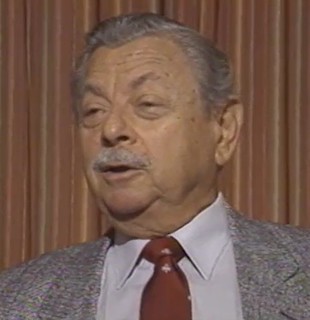 Next month is the 25th anniversary of the passing of my dad--William Fox
"Foxy" Steinberg. I thought this might be a good time to look back at this interview done by David Lisot for the PNG project in 1988--hard to believe that was 32 years ago!
Next month is the 25th anniversary of the passing of my dad--William Fox
"Foxy" Steinberg. I thought this might be a good time to look back at this interview done by David Lisot for the PNG project in 1988--hard to believe that was 32 years ago!
For those of you old enough to remember "Foxy" this short video interview should bring a smile to your face---for those of you who didn't know him (or weren't born yet!) Check it out to get a sense of his personality--as he was an "original character" of our industry in every sense of the word!
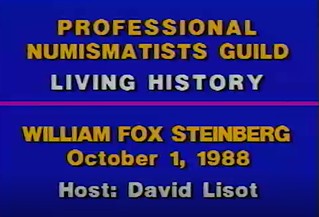 This interview with my late father was done by David Lisot as part of
a Professional Numismatists Guild project to interview old time members before they passed away and get them on videotape! This was back in 1988 (Foxy would have been 75 at the time of the interview) Check it out as I think you might find it interesting--he passed away in 1995--he was one of the founders of Florida United Numismatists (FUN) and one of the early members of PNG and the the International Association of Professional Numismatists (IAPN).
This interview with my late father was done by David Lisot as part of
a Professional Numismatists Guild project to interview old time members before they passed away and get them on videotape! This was back in 1988 (Foxy would have been 75 at the time of the interview) Check it out as I think you might find it interesting--he passed away in 1995--he was one of the founders of Florida United Numismatists (FUN) and one of the early members of PNG and the the International Association of Professional Numismatists (IAPN).
To watch the complete video, see:
PNG Living History: Wm. Fox Steinberg, 10/1/88
(https://nnp.wustl.edu/library/book/578940)

COIN WORLD ON INFLUENCE IN NUMISMATICS
Publication of the Coin World list of The Most Influential People in Numismatics brought forth a number of comments both here and elsewhere. Coin World Managing Editor Bill Gibbs submitted this response. -Editor
 A response to the observations on Coin World's
A response to the observations on Coin World's Most Influential
publication
Ever since Coin World published its The Most Influential People in Numismatics
supplement to our
May monthly issue, our editors, sales representatives and customer service staff have been bombarded
with email and phone calls from readers and advertisers. Many of our customers praised the
publication; some wanted additional copies to keep and share; and others were critical of omissions
(Why isn't he on the list?
and Why am I not on the list
?). Most, however, at least recognize the
monumental effort required by the Amos Media Company to produce and publish the publication.
The last two issues of The E-Sylum have featured comments from readers, first from Pete Smith, whose
wonderful American Numismatic Biographies
is a pioneering work, then from others. Except for David
T. Alexander (whom I have known for more than 45 years since we both worked together at Coin
World), most of responders in The E-Sylum have been critical of our selection of names on the list, decrying a
perceived slant toward individuals from the commercial
side of the hobby/business and a lack of
recognition for researchers and writers.
It is accurate to state that most names on the list come from the commercial side rather than the
research side. Since the readers of E-Sylum are researchers, writers, and editors, I can understand their
feelings of being neglected (I first started writing about coins for school projects as a teen in the late
1960s; I recall going to my English teacher to tell her that her marking of the word disme
as a
misspelling on an assignment was incorrect). All of the names suggested by our critics are certainly
deserving of being recognized as Influential.
However, so do many of the people on our list who are
not researchers and writers. To dismiss dealers, graders, authenticators as not Influential,
as some
critics seem to suggest, is just wrong. The founders of one of the largest auction houses in the world or
the founders of the major grading services are just as influential in the hobby as the writers and
researchers who spend decades studying early American copper or Seated Liberty coinage or national
bank notes. They are just influential in different ways.
To that end, the name of the publication was chosen very carefully. The title is The Most Influential
People in Numismatics,
not The Most Influential Writers in Numismatics
or The Most Influential
Researchers in Numismatics.
We wanted to recognize all segments of the hobby, not just one. Could
we have produced a similar list bearing only the names of researchers and writers? Of course, we could.
However, every such list is controversial; every reader of The E-Sylum, if asked to come up with their list of
Most Influential People in Numismatics,
would come up with a list that differed from every other list.
My personal list would have been different. That is the nature of such lists.
To those critics who say that the list is U.S.-centric, I say guilty as charged.
We are a U.S.-based
publication staffed by editors and writers from the United States, with a subscriber base that mostly
lives in the United States. A broader project would have taken many more months to research, write,
and edit.
The editors, designers, sales representatives, and members of management at Amos Media who worked
on Most Influential
put many hours into this project beyond their regular tasks of producing monthly
and weekly issues of Coin World, maintaining a website and Facebook page, and producing weekly
podcasts. They deserve credit for that. They will deserve credit for future projects. Our Most
Influential
publication was an experiment, and a successful one. It will not be the last such publication
of its kind.
William T. Gibbs, Managing Editor, Coin World
Thank you. Despite the ruckus over inclusion and exclusion, as noted previously the biographical articles were very informative, and I'll look forward to more people-centric articles in Coin World and other numismatic publications.
Brad Karoleff published one such article in this week's Coin World (p35). Check it out. -Editor
To read the earlier E-Sylum articles, see:
ON INFLUENCE IN NUMISMATICS
(https://www.coinbooks.org/v24/esylum_v24n18a11.html)
MORE ON INFLUENCE IN NUMISMATICS
(https://www.coinbooks.org/v24/esylum_v24n19a13.html)
NOTES FROM E-SYLUM READERS: MAY 16, 2021
Jud Petrie's Magic Token ResearchJud Petrie writes:
"I am an avid collector of magic tokens. I was approached a number of years ago to update the Kuethe reference, which I worked on diligently for many years. I then heard that someone else was doing the same thing so I dropped my research efforts as 'I would rather buy his book than write mine'. Nothing was published and I was again approached, and again, I started. I heard that the book was supposed to come out in November, which also came and went without publication.
 "I then became acquainted with Bob Olson, wrote to him, phoned him, attended one of his Colonial era magic shows, and bought many, many tokens from him. As it turns out, we had a number of mutual friends in the magic community. He was the one that was supposedly writing the update. I continued to write in depth articles about the issuers of magic tokens, one was recently published in TAMS titled 'Chicago Magic Bar Tokens'. I had by then become acquainted with Paul Courville and have had many pleasant transactions with him. At this point I would have to say that I am glad that I bought his book because it was better than anything I could have written. Maybe some day I will publish my 'in-depth' research, which continues to this day."
"I then became acquainted with Bob Olson, wrote to him, phoned him, attended one of his Colonial era magic shows, and bought many, many tokens from him. As it turns out, we had a number of mutual friends in the magic community. He was the one that was supposedly writing the update. I continued to write in depth articles about the issuers of magic tokens, one was recently published in TAMS titled 'Chicago Magic Bar Tokens'. I had by then become acquainted with Paul Courville and have had many pleasant transactions with him. At this point I would have to say that I am glad that I bought his book because it was better than anything I could have written. Maybe some day I will publish my 'in-depth' research, which continues to this day."
To read the earlier E-Sylum article, see:
NEW BOOK: MAGIC TOKENS
(https://www.coinbooks.org/v24/esylum_v24n18a04.html)
Adrián González-Salinas of Monterrey, N.L. Mexico has cleared up TWO outstanding numismatic mysteries for us. Thanks! Here's the first - a mystery token submitted in February by Jonas Denenberg. I thought it might be a marriage token. -Editor
Adrián writes:
"You are right Wayne, it's a Mexican marriage token! In the token's obverse the Guadalupe's Basilica is shown and the year 1976 in which it was consecrated. So, it's an "arra" (one of 13 coins given by the bridegroom to the bride)."
For more information, see:
https://en.wikipedia.org/wiki/Basilica_of_Our_Lady_of_Guadalupe
https://en.wikipedia.org/wiki/Juan_Diego
To read the earlier E-Sylum article, see:
NOTES FROM E-SYLUM READERS: FEBRUARY 21, 2021 : Query: Mystery Token
(https://www.coinbooks.org/v24/esylum_v24n08a17.html)
Adrián González-Salinas also has an answer to Len Augsburger's question about a numismatic postcard printer identified as "A.H.H.". -Editor
For more information, see:
http://www.cartophilie.be/
Thank you! E-Sylum readers are the best numismatic detectives! -Editor
To read the earlier E-Sylum article, see:
QUERY: NUMISMATIC POSTCARD PRINTER SOUGHT
(https://www.coinbooks.org/v24/esylum_v24n17a09.html)
 Author and researcher Dave Lange writes:
Author and researcher Dave Lange writes:
"All of my Kent Company and Whitman coin boards are now posted at the Newman Numismatic Portal. I'm going to continue until the entire collection is presented, but this will take months."
Wow - what a great project! Thank you for making these images available to the community. In the don't-try-this-at-home department, Dave suggested illustrating this "First Edition Kent board for Lincolns, which advises users to clean their coins with vinegar and a pencil eraser!" -Editor
To view the image collections on NNP, see (scroll down to Coin Boards):
https://nnp.wustl.edu/library/imagecollections?searchLetter=C#search
Roger Burdette writes:
"Does anyone have a bibliographic or biographic reference for Monsieur Mionet, Librarian (curator) of the French National Museum (1800). I keep getting circular or footnote references in various searches."
Can anyone help? -Editor
Peter Huntoon writes:
"This is associated with the Big Boy steam locomotive that the Union Pacific Railroad recently renovated. Those locomotives were the largest steam locomotives ever made."
 You may have seen this graphic on social media in recent days and wondered just what it meant.
You may have seen this graphic on social media in recent days and wondered just what it meant.
Last month, Astronaut Megan McArthur piloted NASA's SpaceX Crew-2 to the International Space Station, and on board with her is a coin from Union Pacific's Steam Crew. McArthur's son loves trains, and she contacted the Union Pacific Railroad Museum for something train-related that she could take up into space. In honor of the 152nd anniversary of the completion of the Transcontinental Railroad, McArthur plans to show off the coin in space. Follow her on Twitter at @Astro_Megan or Instagram at astro.megan to see it happen!
When McArthur's six-month mission ends, the coin will join the Union Pacific Railroad Museum's permanent collection in Council Bluffs, Iowa.
Thanks - I hadn't seen that. From the Union Pacific Steam Club Newsletter. -Editor
Carol Bastable writes:
"It is not often that one encounters a squirting nickel with the original directions for use. What makes this even more special is that it is also a Disney collectable. This was sold through Disneyland in California. The seller dates it to the 1950s. However, it could also be as late as the 1960s. I expect there are not too many coin collectables sold by Disney aside from some token issues. Unfortunately it is only the price tag that links it to Disney, meaning that it was sold through the Disney park but not actually made by Disney. All the same, it is still pretty cool."
Cool indeed! "The hole is in the 'C' of the word "cents." -Editor
To read the complete lot description, see:
RARE 1950s DISNEYLAND TAYLOR & HUME Merlin's Magic Shop Squirting Buffalo Nickel
(https://www.ebay.com/itm/324620389166)
PAN 2021 SPRING SHOW A BLOCKBUSTER
Readers have had nothing but great things to say about the recent Pennsylvania Association of Numismatists (PAN) show near Pittsburgh. The market continues to grow in strength and draw in new and returning collectors. -Editor
Rich Jewell writes:
"The show was a huge success. Every dealer I spoke to had a good to great show (Bob Hurst, Gus Tiso, Elizabeth Coggan, APMEX, The Reeded Edge, Jewell Exonumia, Cybercoins.net, Running Bear, Dan Olevian Numismatic Rarities, David Kahn Rare Coins) just to name a few!
"The Lecture Series was well attended both Friday and Saturday. The PANKID Zone was well attended Saturday after noon (around 55 YN's and their parents. Bob Stakeley of the History Center gave a very nice presentation entertaining everyone and the kids auction was a great success. Even Lightning Rod Ben Franklin was seen walking the bourse and enlightening everyone (pun intended)!
"Public attendance for the three days was over 1,300."
David Kahn writes:
"The PAN show was crazy-busy, just like the other shows where we've set-up recently...Gettysburg, PA in early April and Manchester, NH the week after that. Pent-up demand for coins is off the charts, and from dealers even more so than from collectors. Make no mistake though...collectors have been out in force, and the ratio of casual browsers to serious buyers is as low as I've ever seen it. "Good quality, real collector coins are truly hard to find, and don't hang around in stock very long. The really great material is nearly impossible to find...and incredibly easy to sell. We started the show low on good inventory, having only 7 long, white slab boxes full (compared to our more typical 9 or 10). At the end, we packed up and took home 4.5 of them, thus we sold roughly a third of our inventory. We were able to buy some coins of course, but I don't think we replaced the number sold.
"Dealer set-up started Wednesday afternoon, and the floor was teeming with folks eager to buy whatever they could get their hands on. It certainly helps that the metals markets are fairly strong, and that there is huge demand from promoters for generic silver dollars of all kinds, from culls to slabbed 66's. Prices for that material are very strong, and seem to be rising still. It was a nearly perfect storm.
"Thursday noon saw the entry of the public, and there was a good line waiting for "first shots". Business was brisk all afternoon, again with serious buyers being the norm. We were almost expecting a repeat on Friday, but even with rainy, cold weather, the public took a little hiatus...thus we only did roughly a "normal" day's business! But, Saturday, folks were back out in force!
"We were awe-struck by the number of kids in attendance on Saturday...and serious kids too. One young man, a 12-year old, came to the table with his mom, and very much impressed all of us with his knowledge and understanding of coins. The kid knew what he wanted, he knew why and he could easily explain it all. Not only remarkable, but refreshing as well. His mom was amazed to get a grasp of her son's level of interest in coins...she knew he liked coins, but had no clue how much! The young man selected a very nice Large cent from our inventory and we sold it to him at a very reasonable price. We always hear that we need to appeal to kids, and that is absolutely true. What is truly great to see is that, at least in a small way, we are succeeding.
"Next up on our show schedule is the brand new show run by Battlefield Coin Shows, in Altoona, PA. We look forward to seeing all of you there, the first weekend in June."
Rich Jewell reports that there were fourteen active exhibits and one non-competitive exhibit at the PAN Show. Rich's Carson City exhibit took First Place.
Chick Ambrass won Second Place for his Leprosy Coinage of Brazil
World Coins exhibit.
Michael Hicks won Third Place for his Numismatic Paper Exhibit-Series 1963B One Dollar Federal Reserve Notes-Barr Notes
and his US Coins exhibit-The Changing Faces of the United States Dollar Coinage from 1878 to 2019
.
In the Exonumia category, Tom Uram's "The Code Talkers of WWI & WWII" took First Place.
-Editor
Tom Uram writes:
"Col. Steve presented Tom Corey and Richard Jewell ANA Presidential Awards. He also presented one to Carlos Kearns. The show was outstanding - dealers were excited, the public was excited, and attendance was up by 30%. The PAN KidZone probably had 40 children there. Bob Stakeley from the Heinz History Center moderated the YN auction. NSS Life is the KidZone sponsor."
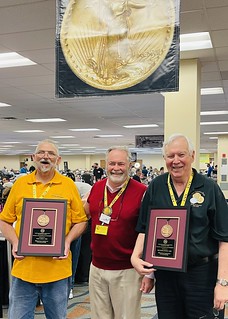

LEFT: Tom Corey, ANA President Steve Ellsworth, Rich Jewell
RIGHT: Steve Ellsworth, Carlos Kearns, Gary Adkins
(Tom Uram photos)
Rick Lank writes:
"The show was well-attended and had more dealers on the bourse floor than in 2019 (Fall) – they expanded the bourse floor into the area where the talks and the KidZone takes place – which is great because it drew more shoppers
and the curious
back to where the talks (and our table) were located.
"We (Becky, my partner, and I) gave three talks on Friday – which for us was by far the most well-attended day – Saturday had a strong attendance for the Kids Programming and Auction (which was good for attracting younger parents and kids).
"I was pleased to see a handful of young women (and guys) listening to Becky's talk, which was geared towards the ladies – it was about the Treasury Girls and women working in the mints as adjusters and later as steam-press operators – and moving into leadership roles at the Mint in the 1900s.
"I gave a talk on Friday about the Phantom Mint of The Dalles Oregon
and the colorful folks of the town of The Dalles in the Civil War and Oregon Trail era; well-attended and well-received.
"Both days I led folks on the Furious Flight of the Confederate Treasure Train
and learned about a possible connection between the fleeing CSA money of '65 and the so-called Randall Horde of large cents – possibly found at a Georgia Railroad station – the story (and possible connection) will go onto the website."
"Pat did his impersonation of Ben Franklin in full costume and on Saturday he drew a good crowd of young parents and their children who were attending the popular KidZone programming."
For Rick and Becky's website, see:
https://talisman-coiner-productions.us/
Ben Franklin (aka Pat McBride) writes:
"I signed future show contracts with the convention center. We all agreed how odd it must have looked with me in costume, so we had to get a photo. This was just before my lecture."
For a photo gallery on our Flickr archive, see:
PAN 2021 Spring Show
(https://www.flickr.com/photos/coinbooks/albums/72157719190898221)
VOCABULARY TERM: EDGE LETTERING, PART 1
Here's another entry from Dick Johnson's Encyclopedia of Coin and Medal Terminology. It's an interesting but lengthy one, so we'll save more for later issues. -Editor
Edge Lettering and Numbering. Marking of any kind – letters, symbols, figures or ornaments – which is placed on the edges of numismatic or medallic items to add decoration, security or additional information about an item. This information may include such data as the identity of the artist, issuer or maker (often in the form of initials, hallmark or logo), the fineness, composition, serial numbering, maker's location, size of edition, copyright, data omitted from the design, the recipient's name or a variety of other facts or symbols.
Edge lettering, or edge stamping, is often as significant as the designs and inscriptions appearing on the obverse and reverse. Most often the information is abbreviated or in the form of symbols and may not be readily understood at first glance. For the person who learns how to decipher edge markings, important details are revealed.
First, if the item contains reeding or knurling on the edge, this usually indicates the piece was struck in a coining press with a single blow. The reeding is formed by the expansion of the blank against a restraining COLLAR. In contrast, a smooth edge reveals very little: it could be struck or cast, produced in a coining press or a medal press; it could have been struck with a collar or without a collar; it could have been trimmed or untrimmed. A smooth edge is like a blank page in a book – something needs to be placed on it to pass information on to the observer.
Lettering was perhaps the first information placed on the edge of a coin or medal. French coins were first issued with lettered edges in 1577. In 1805, Matthew Boulton, then director of the Soho Mint in Birmingham, England, gave to each of the officers engaged in the Battle of Trafalgar a medal that bore a portrait of Lord Nelson. Around the medal was the edge lettering: TO THE HEROES OF TRAFALGAR FROM M BOULTON.
From these early beginnings, coins and medals have come to be considered as having a "third side" for additional design or data. Coins were given such designs – one in particular was called engrailment – as a further protection against counterfeiting. Medals, while less concerned with security or counterfeiting, are generally not decorated around the edge, but often personalized for an individual recipient, or hallmarked attesting to maker and purity.
To read the complete entry on the Newman Numismatic Portal, see:
Edge Lettering and Numbering
(https://nnp.wustl.edu/library/dictionarydetail/515813)
MORE ON DAVID ULYSSES PROSKEY (1853-1928)
Here's more from the David Prosky entry from the online draft of John Lupia's book of numismatic biographies. This is an excerpt with the full article and bibliography available online. -Editor
3. Third Period - 1886 -1887 - The Calman Brothers Syndicate - Scott Stamp & Coin Company, Ltd.
From 1885 to 1887 he published a series on Pattern Pieces based on the work of Robert Coulton Davis in Scott's Coin Collector's Journal.
In 1886, the Proskey Brothers circulated a round brass rimmed cardboard check which they purchased from some unidentified manufacturer. Around the rim printed THIS CHECK IS GOOD FOR/ FIVE CENTS, and second variety reads TWENTY-FIVE CENTS. They handstamped with violet ink a rubber stamp PROSKEY BROS. / MERCHANDISE/ AND SHINGLE MILL/ SILVER SPRINGS, FLA. (See E-Sylum, Vol. 17, No. 4, January 26, 2014, report on ANA Hall of Fame author David Schenkman's article published in The Numismatist)
5. Fifth Period - 1888 - 1901 - Partnership with Harlan Page Smith in New York Coin and Stamp Company.
In the Fall 1887, Proskey was a business partner with Harlan Page Smith in New York Coin & Stamp Company, where Smith served as the financial backer for Proskey to act as the front man buyer and dealer. This afforded Smith the cherry pick the cream of the crop of what came on for his private collection. They employed a clerk at their store, who most probably was David's ten year younger brother Samuel. Smith operated out of New York and Proskey usually from New Jersey, where he lived variously in Little Falls, and also at Patterson, and later in life at North Caldwell. However, they did have an office and coin shop in New York located at 853 Broadway, in the Singer Building, and after the dissolution of the partnership from about 1907 to 1926 at 11 West 30th Street, New York City, New York, and finally from 1926 to 1928, at 912 6th Avenue, which were managed by Proskey.
The 853 Broadway office was also shared by the Proskey Brothers real estate company. The Proskey brothers were also associated with the Allen Brothers, John T. Allen and James G. Allen, in various real estate transactions. Also, the Proskey Brothers about 1891 were located at 371 Fulton Street, Room 129, Arbuckle Building, Brooklyn, New York, managed by Samuel, Nathaniel and Margueritta. Samuel Proskey was one of the real-estate owners of the Spanish-Adams plot of land earmarked for a public park bound by Park and Prospect Places and Kingston and Brooklyn Avenues purchased by this city in April 1892, for $149,000. Samuel Proskey received $45,000 of that sale. The Proskey Brothers also loaned money secured by assets such as stock holdings or land. Throughout the 1890's the Proskey Brothers were very busy in the real estate market, while Samuel was also busy in the coin industry and managed to also serve as the secretary and treasurer of a local Bowling Club at Brooklyn.
After Proskey's death his son David V. Proskey continued the company with the same name at the Little Falls, New Jersey address running full page ads in The Numismatist in 1929 and seems to have been bought out by F.C.C. Boyd after Black Thursday, October 24, and Tuesday, October 29, 1929. In 1940, David V. Proskey was the proprietor of an antiques business.
Fig. 11. The first known coin auction catalogue of New York Coin and Stamp Company held on January 27, 1888, Collection of Clayton A. Smith. The cover illustration of the Brasher doubloon is misleading since it is not offered in the auction. Lot 658 was of a 500 piece stamp collection in an international stamp album. Courtesy Lupia Numismatic Library.Fig. 12. Publicity stunt by Harlan Page Smith and David Proskey to catch the eye and capture the imagination of newspaper readers to spark interest in collecting Roman coins. "A Roman Tribute Money," The News, Tuesday, March 13, 1888, page 4, reprint from the New York World.
To read the complete article, see:
PROSKEY, DAVID ULYSSES
(http://www.numismaticmall.com/numismaticmall-com/proskey-david)
To read the earlier E-Sylum articles, see:
DAVID ULYSSES PROSKEY (1853-1928)
(https://www.coinbooks.org/v24/esylum_v24n18a18.html)
MORE ON DAVID ULYSSES PROSKEY (1853-1928)
(https://www.coinbooks.org/v24/esylum_v24n19a18.html)
DENIS LORING RECEIVES EAC'S SILBERMAN AWARD
Last week's Heritage press release discussed only one of the two recipients of the Herbert Silberman Award by the Early American Coppers Club (EAC). Thanks to Bill Eckberg for providing this text from the club's Penny-Wise publication. -Editor
 The Herbert Silberman Award (President's Award) is
EAC's highest honor and is typically presented to indi-
viduals who have shown exceptional service to their fellow EAC members and to numismatics in general. Only
a few individuals have previously received this award:
The Herbert Silberman Award (President's Award) is
EAC's highest honor and is typically presented to indi-
viduals who have shown exceptional service to their fellow EAC members and to numismatics in general. Only
a few individuals have previously received this award:
1981 - C. Douglas Smith
2000 - Thomas D. Reynolds
2003 - Rod Burress
2011 - Harry Salyards
2014 - Del Bland
2016 - Chris McCawley and Bob Grellman
2018 - Jack Young
I am pleased to announce the following recipients:
From the early days of EAC to now, this person has always done what he thought was in the best interest of the club. In big ways and in small, publicly and in so very many things that you never knew happened, he has jumped in himself, sometimes twisted arms, or given a little nudge so that our club can continue to be the best coin club around. For his long standing support of Early American Coppers, I am honored to award the Silberman award to Denis Loring.
To read the earlier E-Sylum article, see:
BORCKARDT RECEIVES EAC'S SILBERMAN AWARD
(https://www.coinbooks.org/v24/esylum_v24n19a15.html)
ARTICLE HIGHLIGHTS AUTHOR ED FUHRMAN
We recently discussed Ed Fuhrman's new book on Half Cents. Now there's an article about him in the North Jersey Record. -Editor
When heavy metal guitarist Ed Fuhrman hits the road, one of his priorities is seeking out a local collector's shop. Is he looking for a vintage guitar or a hard-to-find record?
No. He's looking for coins.
"I've been playing guitar since I was 10 and teaching guitar since I was 15, but I've been interested in coins since I was 5," Fuhrman said. "I have yet to meet any fellow rockers at a coin show. Quite often, I'm the youngest guy at these events by 10 or 15 years, and I'm 53."
Worried that the art of coin collecting might become lost if not taken up by younger generations, the Dumont resident and New Milford native recently published "The Half Cent Handbook: Draped Bust Varieties 1800-1808." Released in January, it's geared toward beginners, especially young people.
It's the first in a series of four books Fuhrman plans to write on the subject. His second book, "The Half Cent Handbook: Classic Head & Braided Hair Varieties," is due out this summer.
Most coin books are very dry, overly technical, and many are out-of-date," Fuhrman said. "It's like looking at a calculus exam. I wanted to make my book different, more hip, easy to use, and to have some humor. My book is designed as a user-friendly guide to help you learn all about these coins and how to have fun collecting them."
His interest in coins was sparked when he found a box of old currency at his grandfather's house.
"I asked my grandfather if I could keep one of the coins," he said. "My grandfather laughed and said that I could keep the whole box."
 Fuhrman decided to write about half cent coins because he has been specializing in collecting them for 25 years. Half cents are the smallest denomination ever produced by the U.S. mint; they were minted from 1793 to 1857.
Fuhrman decided to write about half cent coins because he has been specializing in collecting them for 25 years. Half cents are the smallest denomination ever produced by the U.S. mint; they were minted from 1793 to 1857.
As a guitarist, Fuhrman is best known for his work with Hades, a popular heavy metal band that released seven albums between 1987 and 2001, and as a longtime Bergen County six-string instructor. He's also played in his own bands, System Addict and Ten Ton Truck.
He said that seasoned coin collectors are similar to talented guitarists. "Both are extremely passionate," Fuhrman said. "There's an adrenaline rush that comes from discovering a new coin or cherry picking, just like there is when you write a good song or come up with a great riff."
To read the complete article, see:
Penny for your thoughts: NJ heavy metal rocker is a coin collector
(https://www.northjersey.com/story/life/2021/05/04/coin-collecting-nj-heavy-metal-guitarist-writes-book-beginners/7350946002/)
To read the earlier E-Sylum article, see:
NEW BOOK: THE HALF CENT HANDBOOK
(https://www.coinbooks.org/v24/esylum_v24n08a06.html)
REVIEW: THE HALF CENT HANDBOOK
(https://www.coinbooks.org/v24/esylum_v24n09a07.html)
BOOK REVIEW: THE HALF CENT HANDBOOK
(https://www.coinbooks.org/v24/esylum_v24n15a06.html)
PAN CLARION INTERVIEWS LIANNA SPURRIER
The May 2021 issue of The Clarion (edited by Rich Jewell for the Pennsylvania Association of Numismatists) includes a nice interview with Lianna Spurrier. With permission, here's an excerpt. -Editor
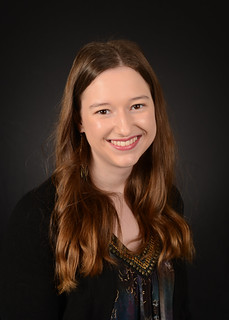 Lianna Spurrier
Lianna Spurrier
Lianna started collecting over 10 years ago and started working in the field professionally in
2018. She's the creative director for Numismatic Marketing and is also an avid collector who's
in the process of researching for a book about Japanese bar money.
1. When and why did you become a coin collector?
When I was little, I got foreign coins from the Tooth Fairy instead of spending money. I
kept them all in a ceramic bank and called myself a coin collector, but I didn't really know
anything about them.
When I was 11, my parents cleaned out a relative's house who was a hoarder. I got to go with them and was oddly excited about spending my Saturday's inside a musty old house with rubber gloves and face masks in August, but it was like a treasure hunt to me. We found a few little stashes of coins tucked away – a jar of wheat pennies here, a metal tin with a Seated Liberty half dollar there – and, since I already thought of myself as a coin collector, I asked to keep them.
Pretty soon I had the wheat pennies sorted out by date and mint mark on our living room floor, telling anyone who would listen why the 1909 S VDB was so special. I was very invested in collecting for a few years until high school sucked up all my free time and replaced all of my hobbies with homework. Near the end of college, when I finally had time for hobbies again, I dove back in and have no intentions of leaving.
2. What are you currently collecting?
My main collection is Japanese bar money; it's a series of gold and silver rectangular
coins issued from 1599-1869. They're very unusual looking, and also very difficult to find and
research. I've always been one for a challenge, so I've sunk my teeth in and eventually plan to
write a book on them to make them more accessible for English speakers. For now, I have a
website with a basic intro to the series at
rectanglecoins.com.
In addition, I have a few cheaper, fun sets. I started a Dansco 7070 type set back in middle school, so I've been gradually filling that in. I also recently started a registry set of toned French Sower francs. When shows are happening, I have a Canadian type set and Fiji Dansco album that I fill in by hunting through bargain bins.
I like to have multiple sets going at different price ranges. The general advice in the industry is to buy fewer, more expensive coins, which is valid; however, there's also a lot to be said for the fun sets. I started off by digging through bargain bins of wheat pennies at flea markets, and that's still one of my favorite things to do at shows. I'm a strong advocate that collections at all budgets are valid and worthwhile.
5. You're the ANA President, name one thing you would do to make coin collecting more attractive to young people?
Man, that is the question, isn't it?
I think one part of the equation that I haven't seen talked about much is putting more emphasis on cheap parts of the hobby. Let's talk about collecting a Dansco album of Jefferson nickels or a 20th century Canadian type set. As a kid, the fancy, high grade pieces were nice to look at, but for me, they were so far out of my budget that they lost my interest. I think any shop that's hoping to attract young people should have some of their cheaper inventory out and displayed right alongside the fancy pieces.
If I hadn't found Don's, with cases full of raw coins that were close to my price range,
there's no telling if I would have kept collecting. The fancy shops seemed to say to 11-year-old
me, You're not old enough for this. You can't afford this,
before the owner even had a chance
to say hello.
Another aspect to that is making those same pieces a bit more glamorous. For example, if you have raw pieces in plastic flips, print off some nice labels for them instead of scribbling on bits of cardboard.
I fully realize that's a large commitment of time, effort, and valuable display space, but if our goal is attracting younger people, we need to make their budgets feel legitimate. If it works, they'll eventually come back with more money and buy the fancier pieces.
Translating that to what I could actually do if I were the ANA President, I would make attractive and editable flip labels easily available, and distribute guides to dealers regarding a recommended amount of coins under $100 or $50 to display. Pamphlets could also be distributed to dealers with introductions to inexpensive and accessible sets, so they can then give those to any young people who enter their shop.
Great idea! Of course, it takes the same amount of time and money to prepare a $5 coin for sale as it does a $50 or $500 one, so dealers naturally focus on the higher end. But it makes perfect sense that more nicely packaged entry-level coins would be more attractive to new collectors. Every dealer would do themselves and the hobby at large a favor by devoting some TLC to some of the lower-priced material in their inventory. It just might inspire a new long-term customer. -Editor
For more information on PAN, see:
https://pancoins.org/
M.S. RAU LAUNCHES NUMISMATICS DIVISION
This press release announces a new high-end dealer in numismatic rarities. -Editor
Internationally recognized antiques dealer M.S. Rau is pleased to announce its expansion into a fascinating product category: numismatics, which includes rare gold coins, silver dollars, ingot and federal notes.
The New Orleans-based gallery's numismatic collection will focus on the most elusive and prestigious coins and banknotes known, including the rarest Early Date specie, ancient gold pieces and shipwreck ingots. Among the initial offerings are such scarcities as an 1880 $4 Coiled Hair Stella (Proof), as well as a one-of-a-kind collection of six gold coins from the S.S. Central America Shipwreck.
"Rare currency was a natural addition to our current offerings," said owner Bill Rau, a third-generation antiques dealer and leader in the industry. "Our clients have come to expect one-of-a-kind, historic luxury items from us, and numismatics tick all of those boxes."
Rau conducted an exhaustive search to find the most highly qualified expert in the field to ensure that the numismatic pieces M.S. Rau offers have the same level of quality and rarity expected in all its acquisitions.
Bruce Smith, an internationally recognized expert in the field, has been appointed the Director of M.S. Rau's new Numismatics division and will play an integral role in sourcing treasures from around the globe.
During his 25-year career in the industry, Smith has had the honor of negotiating some of the most noted specie in the history of the market, including many of the Top 100 coins. A published author in the category, Smith has hosted radio, podcast and speaking forums, and has appeared on various national news platforms for his work.
ABOUT WILLIAM RAU AND M.S. RAU
Considered one of the world's foremost experts on 18th- and 19th-century antiques and fine art, William Rau is President, CEO and third-generation owner of M.S. Rau of New Orleans, Louisiana. Over 105 years old, M.S. Rau is one of the largest premier fine arts and antique galleries in the world. William Rau's extensive knowledge of the international art and antiques market has allowed him to help clients cultivate museum-quality collections.
ABOUT BRUCE SMITH
 Bruce has been involved with rare world-class objects for more than 25 years. A specialist in Numismatics, he has negotiated some of the most noted specie in the history of the market, including many of the Top 100 coins. Having a broad knowledge across many categories, he has placed important art, sculpture, memorabilia, watches and books, among other world-class rarities. Aside from his degrees in theology, he has a wide interest in studies ranging from English literature to politics, finance and leadership. A published author, he has hosted radio, podcast and speaking forums and has appeared on various national news platforms for his work. A father of eight, when not placing rare objects, he is typically on a motorcycle or a tennis court. His passion for rare things is evident and flows from his awareness that collections are about the fundamental appreciation of the human story.
Bruce has been involved with rare world-class objects for more than 25 years. A specialist in Numismatics, he has negotiated some of the most noted specie in the history of the market, including many of the Top 100 coins. Having a broad knowledge across many categories, he has placed important art, sculpture, memorabilia, watches and books, among other world-class rarities. Aside from his degrees in theology, he has a wide interest in studies ranging from English literature to politics, finance and leadership. A published author, he has hosted radio, podcast and speaking forums and has appeared on various national news platforms for his work. A father of eight, when not placing rare objects, he is typically on a motorcycle or a tennis court. His passion for rare things is evident and flows from his awareness that collections are about the fundamental appreciation of the human story.
Direction of Large portfolios//gold and related assets, high value rarities, research and analysis. Managing some of the most extensive and compelling portfolios in numismatics, he applies a research based and relationship driven approach to portfolio direction. For nearly 20 years he has specialized in coins of significant historical importance and high value, placing, amongst others, the 1913 Liberty Head V Nickel, for over $3 million USD. Current projects include a book focused on the Art and Science of Investing in Rarities and Collectible Assets.
They pictured the 1884 Trade Dollar in their ad in the weekend Wall Street Journal. Great publicity for numismatics. -Editor
To see the firm's numismatic offerings:
https://rauantiques.com/collections/numismatics-collection
DAVE & ADAM'S ENTERS NUMISMATICS
The numismatic dealer field isn't only expanding from the high end. This NGC press release announces the entry of a major dealer from the sports card world. -Editor
 Numismatic Guaranty Corporation® (NGC®) has certified one of the finest
examples of the famed 1943 Bronze Cent, an elusive mint error highly prized by coin collectors. The coin was
submitted by Dave & Adam's Card World, a powerhouse in the world of collectible sports cards.
In order to save copper for the war effort during World War II, the US Mint was supposed to strike all 1943 Lincoln
Cents on zinc-coated steel planchets. However, a few bronze planchets from 1942 are believed to have been
lodged in the tote bins that were used by Mint employees to carry the unstruck planchets to the presses that
struck the coins. These stray bronze planchets later worked themselves loose, mixing with the steel planchets
used to strike the cents.
Numismatic Guaranty Corporation® (NGC®) has certified one of the finest
examples of the famed 1943 Bronze Cent, an elusive mint error highly prized by coin collectors. The coin was
submitted by Dave & Adam's Card World, a powerhouse in the world of collectible sports cards.
In order to save copper for the war effort during World War II, the US Mint was supposed to strike all 1943 Lincoln
Cents on zinc-coated steel planchets. However, a few bronze planchets from 1942 are believed to have been
lodged in the tote bins that were used by Mint employees to carry the unstruck planchets to the presses that
struck the coins. These stray bronze planchets later worked themselves loose, mixing with the steel planchets
used to strike the cents.
Not long after the steel cents reached the public, rumors circulated that a major automobile manufacturer was offering a car to anyone who found a 1943-dated cent struck in the wrong metal. This bit of whimsy had an unanticipated effect: In 1947, a Massachusetts teenager reportedly discovered the first example of this spectacular mint error, which is often called a 1943 Copper Cent because the alloy it is made of is predominantly copper.
About two dozen others have come to light, including the one purchased by Dave & Adam's, which is called the Marvin Beyer Discovery Coin after the boy who found it in 1957. In addition to its relatively high grade, it also boasts a stellar bluish toning.
The Beyer Discovery Coin is the first coin purchased by Dave & Adam's. It was in the holder of another grading service and Dave & Adam's submitted it to NGC through its CrossOver service. It is now graded NGC MS 62 BN.
We think this is an excellent time to leverage the success we have had in collectible sports cards and apply it to
rare coins,
said Adam Martin, Co-founder of Dave & Adam's. Collectors are highly interested in rarities like
these, especially when they know they are authentic and are assured that their grade is accurate, which NGC
certification does.
NGC is part of the Certified Collectibles Group® (CCG®), whose affiliates have certified more than 60 million collectibles since 1987. Other affiliates include Paper Money Guaranty® (PMG®) for banknotes; Certified Guaranty Company® (CGC®) for comic books, magazines, posters and, through its CGC Trading Cards division, Pokémon and Magic: The Gathering cards; and Certified Sports Guaranty™ (CSG™) for sports cards. Dave & Adam's was one of the first Official Submission Centers for CSG and CGC Trading Cards.
I'm delighted to see Dave & Adam's expanding into numismatics,
said Mark Salzberg, NGC Chairman and
Grading Finalizer. Clearly, more and more people are embracing the tremendous opportunity that rare
collectibles represent, whether we're talking about a 1943 Bronze Cent or a high-grade Michael Jordan rookie
card.
Roger Siboni writes:
"Cards to coins! There is a turnabout. I remember 20 plus years ago you couldn't give away baseball cards. Now they are the rage and card powerhouses that are very influential with millennials are expanding to coins. I find this an interesting demographic moment. Not sure it is a trend. But a moment."
TARGET HALTS SALES OF TRADING CARDS
We haven't exactly seen fistfights break out among coin buyers, but the sports card market is so hot people are brawling to grab the latest offerings at big-box stores. The Washington Post reports that Target is suspending card sales following a donnybrook in in Wisconsin. -Editor
 Target says it's done with trading cards — at least for the time being — after a dispute outside one of its Milwaukee-area stores escalated into violence and multiple arrests.
Target says it's done with trading cards — at least for the time being — after a dispute outside one of its Milwaukee-area stores escalated into violence and multiple arrests.
A spokesman for the retail giant said in a statement that it will stop selling MLB, NFL, NBA and Pokémon cards in stores on Friday out of an abundance of caution,
but that they'll still be available online.
The company declined further comment.
Demand at retail establishments, especially big-box stores, has swelled, collectors say, as enterprising card flippers
descend on stores, purchase their inventories and resell them at sometimes four or five times their retail price online, where The Hobby,
as collectors affectionately call it, has been sequestered during the coronavirus crisis.
But collectors say it was getting harder to come by new cards at big-box stores even before the pandemic because flippers are notorious for scouting out stores' restocking schedules and parking themselves in front of store entrances early in the morning to buy up inventories.
It has led to a surge in valuations for cards of all types, with some Pokémon cards quadrupling in value in the past year. One collector told The Washington Post he has sold baseball cards in recent months once worth $50 each for upward of $500. It's also ignited fierce competition between flippers angling for hits,
or the most valuable cards.
The new entrants have divided the hobby squarely into two camps: Traditionalists who buy and sell cards as a pastime; and new-school collectors who trade cards as they would investments, looking to short the market and take advantage of the space's volatility. The trend has repeated itself in other collectible markets through the pandemic, including comic books, coins and stamps.
It's collectibles versus commodities. That's what we're facing right now,
said one collector, who goes by the name Kyle and runs the Wax Museum
basketball card podcast. Like many collectors, he prefers to shield his identity to avoid online harassment from other collectors. That's been the new wave during the pandemic. There's a lot of nostalgia with cards, but people see the sales. They think they like the cards — maybe they have a past connection to them — but they really see the money. It's more interesting than the stock market,
he said.
It's probably easier to project a player that's going to get better than analyze tech start-ups.
The surge in interest has renewed connoisseurs' concerns about fraud, which is rampant in the hobby. New collectors make for easy marks for so-called doctors, who illicitly alter cards to improve their appearance and resubmit them to grading companies in hopes of higher appraisals. Rising prices have only increased incentives for such activity, and doctoring scandals within the hobby have led to high-profile prosecutions and federal criminal investigations.
To read the complete article, see:
‘Collectibles versus commodities': As Target halts sales of trading cards, collectors reckon with fast-changing hobby
(https://www.washingtonpost.com/business/2021/05/13/target-pokemon-baseball-cards/)
SOVEREIGN RARITIES AUCTION 4 PREVIEW
In a recent email Sovereign Rarities reviewed several lots consigned to their planned Auction 4. The lots are still being catalogued, but here are images of some pieces that caught my eye. -Editor
For more information, see:
https://www.sovr.co.uk/
2021 ANA WORLDS FAIR OF MONEY EXHIBITS
Paul Hybert submitted this information about exhibits at this summer's American Numismatic Association convention. Thanks. -Editor
It is good to see that the ANA will meet in August in Rosemont, and that The E-Sylum is spreading the information.
The main webpage for the convention is https://www.money.org/worldsfairofmoney/ which was listed in the last E-Sylum. Near the top of the page is a bullet-list of links for some aspects of the show -- farther down the page is a grid of graphics for more aspects of the convention. Near the bottom is the "EXHIBIT INFORMATION" graphic which is a link to information on the Collector Exhibit Area.
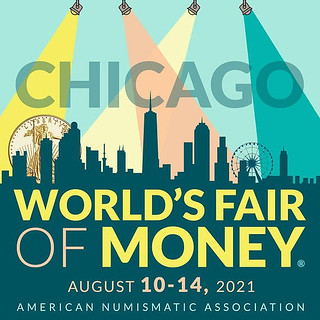 This year's Collector Exhibit Area will differ from recent years due to
restrictions arising from Covid-19. The current plan is to have:
This year's Collector Exhibit Area will differ from recent years due to
restrictions arising from Covid-19. The current plan is to have:
- The usual 21 Classes are out, replaced by the 6 Classes used during the National Money Show (spring ANA convention).
- A limit of 8 cases for one exhibit, and only one exhibit per exhibitor.
See the Rules and Application documents at:
https://www.money.org/numismatic-events/convention-exhibits
(In these documents, the page breaks and formatting are a little "off" as of May 12, but they are usable. Corrected documents are expected.)
To read the earlier E-Sylum article, see:
2021 ANA WORLD'S FAIR OF MONEY CONFIRMED
(https://www.coinbooks.org/v24/esylum_v24n19a24.html)
INTERNATIONAL TOKEN WEB CONFERENCE
Yosef Sa'ar passed along this information about the upcoming International Token Web Conference. Thank you! -Editor
International Token Web Conference
22-23 May 2021
The International Token Web Conference is back.
The past year was hard on everyone and we all deserve a full weekend of token-happiness. As it turns out, the online conference format was very successful and proved to be effective on getting to know new subjects and new persons, without pandemic risks or even the hassle and expenses of travel. So here we go again.
As before, the event will be free and present renowned token experts from all over the world and a public from all the continents.
The organization felt the responsibility to do even better this year. The event will hold Thematic Rooms spread all over the whole weekend. These will be Zoom meetings with smaller groups that will talk informally about the theme of the room, while at the same time bringing together people with the same interests. Even If you are in Hawaii, Australia or Kiribati, you are no longer limited by the time zone, you can propose a Thematic Room and schedule a proper hour for your attendees.
Free registration is now open, and we are taking proposals for Thematic Rooms. You can find all the information at the official event website.
George Cuhaj adds:
"I am doing a break out session on Transit tokens."
Free registration, schedule, and all the info at:
https://tokenconference.numismatas.com/
JEWISH AMERICAN HERITAGE MONTH TALKS
The American Israel Numismatic Association (AINA) is offering two free Zoom talks for Jewish American Heritage Month. Here's the announcement. -Editor
Mel Wacks and Joel Iskowitz Talks Celebrate Jewish American Heritage Month
 May has been proclaimed Jewish American Heritage by every President from George W. Bush to Joseph Biden. On May 23 at 2 PM Eastern Time, Mel Wacks, President Emeritus of AINA and Director of the Jewish-American Hall of Fame will present a lecture via Zoom on
May has been proclaimed Jewish American Heritage by every President from George W. Bush to Joseph Biden. On May 23 at 2 PM Eastern Time, Mel Wacks, President Emeritus of AINA and Director of the Jewish-American Hall of Fame will present a lecture via Zoom on Important Jewish American Medals and Coins.
He will be followed by Joel Iskowitz, longtime participant in the U.S. Mint Artistic Infusion Program, where Joel designed over 50 coins and medals; he will talk about The Victor D. Brenner – Joel Iskowitz Connection and Recent Projects.
To join Zoom meeting, sponsored by the American Israel Numismatic Association (AINA), use the following link or the information that follows:
https://us02web.zoom.us/j/89743066171?pwd=d28xcmZWK0NUd1RSMEJiZVNKZFpxZz09
Meeting ID: 897 4306 6171
Passcode: TheShekel
One tap mobile: +13017158592,,89743066171#,,,,*550333763#
 Mel's illustrated talk will begin with the earliest known Jewish American medal, created in 1784 by the colonial silversmith Myer Myers to celebrate a circumcision. The talk will conclude with a dollar in the American Innovation dollar series – issued this year – commemorating the inventor of the first video game console (Odyssey), Ralph Baer.
Mel's illustrated talk will begin with the earliest known Jewish American medal, created in 1784 by the colonial silversmith Myer Myers to celebrate a circumcision. The talk will conclude with a dollar in the American Innovation dollar series – issued this year – commemorating the inventor of the first video game console (Odyssey), Ralph Baer.
 Joel has felt a particular tie with the early 20th century medalist Victor David Brenner, particularly in that Brenner designed the first Lincoln Cent in 1909, while Iskowitz designed the
Joel has felt a particular tie with the early 20th century medalist Victor David Brenner, particularly in that Brenner designed the first Lincoln Cent in 1909, while Iskowitz designed the Professional Life in Illinois" cent, third of the four cent designs celebrating the centennial of the Lincoln Cent in 2009.
For further information on AINA, visit www.TheShekel.org
For further information about the Jewish-American Hall of Fame, visit www.amuseum.org/jahf/
For further information on Iskowitz' Lincoln Cent design, visit https://www.usmint.gov/coins/coin-medal-programs/lincoln-bicentennial-one-cent-coins/professional-life-in-illinois
NUMISMATIC NUGGETS: MAY 16, 2021
Here's a selection of interesting or unusual items I came across in the marketplace this week. Tell us what you think of some of these. -Editor
UNITED STATES. John Paul Jones (1747-1792) Medaglia 1779 (opus: A. Dupré) (56 mm.) La cattura della fregata britannica HMS Serapis da parte della USS Bonhomme Richard. Per la series "Comitia Americana". Busto in uniform verso ds. con i capelli raccolti R / L'impegno navale, HOSTIVM NAVIBVS CAPTIS AVT FVGATIS, Scontro tra vascelli. Betts 568; Adams e Bentley, cap. 8th; BHM 222, R2; MH 580; CP 105/22; Ford XIV, 203rd SPL +
From the upcoming Bertolami Web Auction 100. See the article elsewhere in this issue about numismatic literature offered in the sale. -Editor
To read the complete lot description, see:
LOT NO. 1360 - WEB AUCTION 100
(https://auctions.bertolamifinearts.com/de/lot/101966/usa-john-paul-jones-1747-1792-medaglia-/)
A decent Feuchtwanger cent. -Editor
To read the complete lot description, see:
1837 Feuchtwanger One Cent Hard Times Token AU-55 PCGS
(https://www.liveauctioneers.com/item/103555387_1837-feuchtwanger-one-cent-hard-times-token-au-55-pcgs)
Apollo-Soyuz Test Project Flown Silver Robbins Medallion, Serial Number 43F, Personally Presented by Deke Slayton to and Directly from the Estate of NASA Legend Chris Kraft, with Slayton's Signed COA and Handwritten Letter of Appreciation. This 35mm sterling silver medal is one of only ninety-three flown (of 285 minted) aboard the Apollo-Soyuz Test Project, the first international manned space effort, July 17-19, 1975, with U.S. crewmembers Thomas Stafford, Vance Brand, & Deke Slayton and Soviet crewmembers Alexei Leonov & Valery Kubasov. The obverse features the mission insignia depicting the docking maneuver above the Earth and the names of the mission and crewmembers. The reverse features the title "First Joint U.S.-U.S.S.R. Space Flight" and the engraved dates. The serial number is on the rim along with the sterling and Robbins hallmarks. This mission effectively ended the "Space Race" between the U.S. and the U.S.S.R. We seldom are able to offer flown examples of this mission's medal and this one is likely the nicest we have ever handled.
Cool space item from the Heritage May 21-22 Space Exploration Auction. -Editor
To read the complete lot description, see:
Apollo-Soyuz Test Project Flown Silver Robbins Medallion, Serial Number 43F, Personally Presented by Deke Slayton to and Dire...
(https://historical.ha.com/itm/explorers/space-exploration/apollo-soyuz-test-project-flown-silver-robbins-medallion-serial-number-43f-personally-presented-by-deke-slayton-to-and-dire/a/6238-50034.s)
$5 OBSOLETE BANK NOTE. ISSUED BY THE BANKING DEPARTMENT OF THE VERMONT COMMERCIAL COLLEGE AND USED FOR TEACHING, NEAT PIECE OF HISTORY
College currency is an interesting numismatic sideline. -Editor
To read the complete lot description, see:
1866 SECOND NATIONAL COLLEGE BANK, VERMONT
(https://auctions.bidalotcoinauction.com/lots/view/1-4LJ4DK/1866-second-national-college-bank-vermont)
ROMAN PRAETORIAN GUARD COINS FOUND
Coins are mentioned but not shown in this article from The Sunday Times shared by David Sundman. -Editor
Hundreds of ancient Romans fleeing the eruption of Vesuvius in AD79 were minutes away from being rescued on a boat sent by the historian Pliny the Elder when they perished, an expert has claimed.
The skeletons of 300 inhabitants of the coastal town of Herculaneum were discovered in the 1980s huddled with their jewellery on the town's beach, killed by a tide of boiling volcanic material as they waited to be saved.
Historians have suggested they were close to being picked up by a rescue mission ordered by Pliny, who was commander of the local naval fleet; Francesco Sirano, the director of the archaeological site at Herculaneum, says he may now have clinching proof of this.
The ornate weapons and the rucksack found with one of the skeletons, known as No 26, suggest he was part of the doomed mission sent by Pliny, which is why the locals look like they were lining up calmly to board his boat,
Sirano said.
Herculaneum was buried under 20 metres of volcanic material that hardened into rock, allowing the preservation of wood, albeit carbonised, unlike at its more famous neighbour, Pompeii.
When the eruption was spotted by Pliny from Misenum, across the Bay of Naples, he ordered the galleys to be put to sea
, his nephew, Pliny the Younger, wrote. Pliny the Elder boarded one vessel, braving scalding rock crashing on the decks and telling his captain, Fortune favours the brave
before he died, possibly of a heart attack, after landing at the town of Stabiae.
On the beach at Herculaneum, which is now 500 metres inland, the remains of a nine-metre-long rowing boat thought to be military suggests that Pliny's ships also made it there.
Near to the boat lay skeleton No 26, a man aged between 40 and 45, in good health who was thrown face down into the sand by the force of the eruption.
Thought to be a regular soldier because of his sword and dagger, Sirano said that the latest research showed that he was probably from the elite Praetorian Guard.
The coins he carried — 12 silver denarii and two golden denarii — were equal to the month's salary paid to the Guards, he added.
Daivd adds:
"This is an interesting find and theory. Herculaneum is a very nice site, and much more compact than Pompeii. I was fortunate to visit the site in November 2019, just before COVID-19 hit."
To read the complete article (subscription required), see:
Clue that ancient Romans were close to being saved from Vesuvius
(https://www.thetimes.co.uk/article/clue-that-ancient-romans-were-close-to-being-saved-from-vesuvius-tdfxkxjf0)
WHAT ANCIENT COINS TELL US
Numismatourist Howard Berlin passed along this Jerusalem Post article about symbolism on ancient coins. -Editor
 What do ancient coins tell us about the Omer period and the time of the Bar-Kochba revolt, when the 49 days between Passover and Shavuot became associated with death and mourning?
What do ancient coins tell us about the Omer period and the time of the Bar-Kochba revolt, when the 49 days between Passover and Shavuot became associated with death and mourning?
According to the Bible, the seven weeks between the two holidays referred to as ‘omer' – a unit of measure which was used to quantify the amount of produce to offer as a sacrifice to God – was not meant to carry any specific connotation other than its agricultural meaning.
A window into that period and the life in the land of Israel during those years can be opened today through an unexpected means: the ancient coins minted by the rebels.
Coins were considered an expression of sovereignty,
Donald T. Ariel, head of the Coin Department at the Antiquities Authority (IAI), told The Jerusalem Post. Minting coins meant to be free.
The symbolism behind the coins is clearly stated in the ornaments they feature. They include the Temple facade, trumpets, a harp/violin, vine leaves, palm trees – which at the time were considered the ultimate symbol of Judea – as well as writings such as Year One of the Redemption of Israel
or Year Two of the Freedom of Israel
and Jerusalem.
The revolt – also known as the Third Jewish Revolt – broke over the religious restrictions imposed by the Romans, as well as their decision to build a Roman city over the ruins of Jewish Jerusalem, including a pagan sanctuary where the Temple had stood.
The geographic distribution of the coins found offers important insights into the vicissitudes of the revolt; as much as the insurgents yearn to return to Jerusalem, they were not able to.
Some 22,000 coins have been excavated in the area of the Old City of Jerusalem. Of those, three were Bar-Kochba coins. Another few were found in other areas of modern Jerusalem. This is important evidence showing that the city was never captured by the rebels,
Ariel said.
To read the complete article, see:
What do ancient coins tell us about Bar Kochba and the Omer period?
(https://www.jpost.com/archaeology/what-do-ancient-coins-tell-us-about-bar-kochba-and-the-omer-period-667775)
THE BOOK BAZARRE
MARY BEARD FUNDS CLASSICS SCHOLARSHIPS
David Sundman passed along this BBC News article about two scholarships in classics funded by historian Mary Beard. -Editor
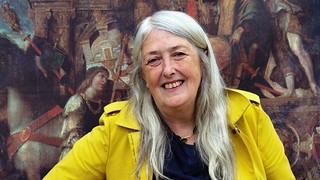 Historian Mary Beard is to fund scholarships for two disadvantaged students to study classics at Cambridge University, as a "retirement present".
Historian Mary Beard is to fund scholarships for two disadvantaged students to study classics at Cambridge University, as a "retirement present".
The Cambridge professor is stepping down next year after almost 40 years of teaching and research.
She described the £80,000 donation as her "payback time".
"I am very conscious of what I've gained from classics, no-one from my family had a university degree," said Dame Mary.
The historian and television presenter wants to help widen the reach of classics as a subject, so it's not "just for posh people who've done Latin for ages".
Most people approaching retirement might expect the present to be heading in their direction, but Dame Mary - no stranger to doing things her own way - wants to mark her departure with her own donation.
Her BBC television series, such as Julius Caesar Revealed and Mary Beard's Ultimate Rome: Empire Without Limit, have brought ancient history to a wider, modern audience.
Dame Mary said her own interest in classics was through an early enthusiasm for archaeology, and she remembers the excitement of finding a Roman coin and "holding the past".
One of her earliest memories, she said, was being taken by her mother to the British Museum as a small child, and an attendant being kind enough to open a display case to let her hold a piece of ancient Egyptian carbonised cake.
She now wants to help open up classics for another generation of young people.
To read the complete article, see:
Mary Beard's retirement present to fund students
(https://www.bbc.com/news/education-57102489)
GOLD BRACTEATES FOUND IN NORWAY
Nick Graver passed along this Smithsonian article about gold bracteates unearthed in Norway. Thanks -Editor
 In the sixth century A.D., elite individuals in southeastern Norway buried seven gold pendants in a field as a sacrifice to the gods. The artifacts, known as bracteates, feature images of Norse gods and stylized animal figures, reports Ida Irene Bergstrøm for Science Norway.
In the sixth century A.D., elite individuals in southeastern Norway buried seven gold pendants in a field as a sacrifice to the gods. The artifacts, known as bracteates, feature images of Norse gods and stylized animal figures, reports Ida Irene Bergstrøm for Science Norway.
A private metal detectorist and archaeologists from Viken County discovered four of the bracteates in the municipality of Råde in 2019. The University of Oslo's Museum of Cultural History found the other three while conducting a follow-up excavation at the site in 2020. Only one similar pendant has been found in Norway over the past 70 years, according to the archaeologists.
Overall, researchers have found about 900 bracteates to date, 160 of them in Norway. The artifacts are specific to Scandinavia, though some have been found in Germany and England, presumably as imports from northern countries.
Bracteates are thin and heavily decorated. Per the Metropolitan Museum of Art, they represent a Scandinavian take on Roman and Byzantine portrait medallions, which emperors presented as gifts to important people. Fifth- and sixth-century Scandinavians wore the pendants to convey high status or kept them as treasure.
People in Scandinavia took ownership of a status item from the Roman culture, gave it a Norse look and made it their own,
say archaeologists Jessica Leigh McGraw, Margrete Figenschou Simonsen and Magne Samdal of the Museum of Cultural History in a statement, per a translation by Science Norway.
The Rådehorde includes four artifacts identified as C-type bracteates, meaning they're stamped with an image of a human riding a horse with horns. The researchers say this figure may represent the god Odin riding Sleipnir, his eight-legged horse, or Odin's son Hermod riding to the realm of the dead.
The other three bracteates are classified as D-type and depict animal figures. The researchers say these animal motifs probably contain symbolism that they can't fully interpret. But the finds did help the team date the horde, since D-type bracteates only began appearing in the sixth century.
To read the complete article, see:
Ancient Norse Elites Buried These Gold Pendants as Sacrifices to the Gods
(https://www.smithsonianmag.com/smart-news/1500-year-old-pendants-found-norway-180977705/)
THE 1969-S DOUBLED DIE CENT
The Heritage press release describes a modern rarity with an interesting backstory. -Editor
Seeing Double! Rare Doubled Die Cent Could Sell For Six Figures
Every week, our coin staff at Heritage receives multiple inquiries from hopefuls who are searching their pocket change for treasures. One such lucky consignor has entrusted a modern rarity to Heritage for sale in January: a 1969-S Doubled Die Cent! This coin has been authenticated by PCGS and certified as an amazing MS64 Red. It will be featured in the June US Coin Auction #1331.
The 1969-S Doubled Die is the key coin to the Lincoln Memorial Cent series that began in 1959. The doubling is very obvious and can be seen by the naked eye--this is a major variety that is clearly visible even to the non-collector. Relatively few of these scarce pieces have been located and certified, making them a true prize for the Lincoln Cent or variety collector! When you look at this coin, you might feel that you have double vision.
Graded 64 Red by PCGS, this coin has a fascinating backstory. The 1969-S is was one of the only coins to be famous for having once been believed to be a counterfeit. Coincidentally, this definitely-real variety was also copied to create an actual counterfeit--the 1969 Doubled Die without the "S" mintmark. Two men, Morton Goodman and Roy Gray, had begun making fake 1969 Doubled Die cents in 1969, which soon got them into legal trouble. They were striking and selling supposed "variety coins" that were actually just fakes and marketing them through a coin collector who first sold the fake coins for a profit but later turned Goodman and Gray in to the Secret Service! The Secret Service raided one of their homes in the "Summer of 69" as the song tells us, and they discovered incriminating evidence. Gray's home was full of the makings of the counterfeiter's art: planchets, machinery, and punches for coins to deceptively re-create what can only be made officially by the US Mint.
While agents continued investigating and proved Goodman and Gray were guilty of counterfeiting, a real rarity was actually coming out of the woodwork through legal channels. While the 1969 Doubled Die with no mintmark is fake, the 1969-S Doubled Die from San Francisco is real and valuable! These rare coins were discovered, bit by bit, by both collectors and the Secret Service (who was searching for fake coins to take off the market after the Goodman and Gray scandal.) In the search for fake coins, the agents actually found some real ones!
However, this crazy crime story actually led to the true variety that Heritage is selling in the upcoming auction being rarer, because the Secret Service destroyed some of the REAL 1969-S Doubled Dies while culling out the FAKE 1969 coins from Goodman and Gray. While the counterfeiters ended up going to jail, their crimes actually led to a rare coin being even rarer!
While no one knows the mintage of the 1969-S Doubled Die for certain, some estimates say that less than 50 exist today. In addition, the example being offered by Heritage is in far nicer condition than is usually seen and had full red color! The last time a similar coin sold at Heritage 10+ years ago, it brought over $100,000. Relatively few are graded in any grade today, so don't miss your chance to get your hands on one here:
https://coins.ha.com/itm/lincoln-cents/p/1331-58001.s
THE NEW COIN SHORTAGE OF 2021
Federal Reserve is again limiting coin shipments to banks in response to an unexpected increase in demand. The new limits are modest compared with those set last summer, which were eased earlier this year. Is it the economy ramping up? Or have people just gotten used to not spending their change? -Editor
 The Federal Reserve continues efforts to manage the distribution of the Federal Reserve's coin inventory and new coin produced by the U.S. Mint in a fair and equitable manner. Our focus is on ensuring that businesses and consumers continue to have ready access to U.S. coin during the COVID-19 pandemic. To meet increased demand for coin fairly and equitably across all depository institution (DI) customers, the Federal Reserve Banks will begin to allocate coin in DI orders for dimes and quarters, beginning with orders placed for pick-up on Monday, May 3, 2021.
The Federal Reserve continues efforts to manage the distribution of the Federal Reserve's coin inventory and new coin produced by the U.S. Mint in a fair and equitable manner. Our focus is on ensuring that businesses and consumers continue to have ready access to U.S. coin during the COVID-19 pandemic. To meet increased demand for coin fairly and equitably across all depository institution (DI) customers, the Federal Reserve Banks will begin to allocate coin in DI orders for dimes and quarters, beginning with orders placed for pick-up on Monday, May 3, 2021.
Why we are allocating coin again
After a relatively stable first quarter of 2021, coin orders from DIs began to increase in March, with the most dramatic increase seen in the first two weeks of April. In addition, coin deposits to the Reserve Banks have been on a slow decline since January. What initially appeared to be the normal seasonal increase in coin orders typical in the Spring has developed into a sustained trend that significantly exceeds typical seasonal patterns. The U.S. Mint continues to produce new coins at increased production levels; however, increased demand from DIs is outpacing U.S. Mint production and resupply available from low rates of deposits, resulting in the Federal Reserve's coin inventory being reduced to below normal levels.
To read the complete article, see:
2021 Strategic Allocation of Federal Reserve Coin Inventories
(https://www.frbservices.org/news/communications/042821-cash-2021-strategic-allocation-federal-reserve-coin-inventories.html)
To read earlier E-Sylum articles, see:
MORE ON THE COVID-19 COIN SHORTAGE
(https://www.coinbooks.org/v23/esylum_v23n28a14.html)
THE COVID-19 COIN SHORTAGE
(https://www.coinbooks.org/v23/esylum_v23n25a11.html)
MINT DIRECTOR MOY ON THE COVID-19 COIN SHORTAGE
(https://www.coinbooks.org/v23/esylum_v23n30a11.html)
TREASURY SECRETARY OFFICE CURRENCY DISPLAYS
This article from the Wall Street Journal is non-numismatic, but what caught my eye was in the background of the embedded video of Treasury Secretary Yellen speaking from her office. Here's a still shot. -Editor
Check out the framed display of U.S. currency on the right. And if you look close, you'll see another framed display reflected in the mirror on the wall behind her desk. Very cool. In 2004 I visited the American Numismatic Association headquarters in Colorado Springs and in a conference room there was a similar frame on loan from the U.S. Treasury. Is it still there? Has anyone ever done an inventory of these framed government collections? -Editor
To read the complete article (and watch the video), see:
Stocks Rise to End Turbulent Week of Trading
(https://www.wsj.com/articles/global-stock-markets-dow-update-05-14-2021-11620978526)
THEORY: CURRENCY "PREDICTED" COVID PANDEMIC
Kavan Ratnatunga writes:
"Have you seen the old 9/11 conspiracy theory on US currency being extended to Covid-19 of Jackson with mask in 2020?"
I hadn't seen this one yet. The older one involves folding a note to where the image could be interpreted as showing the burning twin towers of the World Trade Center. -Editor
There is absolutely no end to conspiracy theories. Be it the Bermuda triangle or the Illuminati, or for that matter, animated shows like Simpsons, which many think has predicted major events such as the election of Donald Trump as the President of the United States of America.
To some these conspiracy theories are extremely interesting while some get extremely disturbed knowing them. Though most people thrash them as useless, they do create a certain interest among a large number of people.
A video of one such conspiracy theory is doing the rounds on the internet of late. A video, likely made by an American man, shows how the currency bills printed from 1996-1999, in sequence predicted the 9/11 attacks on the World Trade Centre and the Pentagon. What is more interesting is that the man who made the video also shows how $ 20 bills depict a man wearing a mask
in the year 2020, hinting at the Covid-19 pandemic.
To read the complete article (and see the video):
Conspiracy theorists at it again: Call Covid-19 planned
(https://telanganatoday.com/conspiracy-theorists-at-it-again-call-covid-19-planned)
BITCOIN ATMS APPEARING
Electronic money is creeping ever closer to ubiquity. One company has been rolling out BitCoin ATMs across the U.S. -Editor
 Bitcoin of America is making a push to expand its operation in South Florida.
Bitcoin of America is making a push to expand its operation in South Florida.
Its CEO, Sonny Meraban, took his plans to the city of Miami mayor with great reception.
We actually had a conversation with Mayor Francis Suarez where we saw he wanted to bring Bitcoin and crypto to the city of Miami,
Meraban said.
Purchased bitcoin actually goes into a virtual wallet or app, which only the owner has access. You can transfer the virtual cash to retailers who accept crypto.
Bitcoin can also be bought. It's currently is trading at roughly $57,000 a coin.
And no, there's not an actual little gold coin.
Now, Meraban is placing bitcoin ATMs all over South Florida. Bitcoin of America has placed roughly 50 throughout the area.
Meraban said, Our goal is to get about 200, and we'd like 100 of those in the city of Miami.
The bitcoin ATMs will start appearing in more and more gas stations, convenience store, groceries – any high foot traffic areas.
I'd gotten busy and forgotten about the above photos I'd taken April 30th at a convenience store about a mile or so from our house here in Northern Virginia. These are in states all across the U.S. now. Has anyone spotted one in their area? Anyone tried to use one? -Editor
To read the complete article, see:
Company Placing Bitcoin ATMs All Over South Florida
(https://miami.cbslocal.com/2021/05/11/company-placing-bitcoin-atms-all-over-south-florida/)
To visit the Bitcoin of America website, see:
https://www.bitcoinofamerica.org/
THE BOOK BAZARRE
HYBRID CRYPTO-BANKNOTES PROPOSED
Are smart banknotes, cryptoNotes and crypto bills on the way? Here's a proposal for a form of hybrid crypto-banknote straddling the physical and electronic realms. -Editor
 As central bank digital currencies (CBDC) become reality and the use of cryptocurrencies for payments becomes more mainstream, how do we make sure these new digital monies are available to everyone, everywhere, at all times? To date, the only payment technology that can do this is cash.
As central bank digital currencies (CBDC) become reality and the use of cryptocurrencies for payments becomes more mainstream, how do we make sure these new digital monies are available to everyone, everywhere, at all times? To date, the only payment technology that can do this is cash.
The pure physicality of banknotes presents problems in the digital age. International remittances are slow, holding banknotes can be costly and problematic, and cash can impede central bank monetary policy (such as by breaking the zero lower bound in interest rates).
It seems only logical that an ideal payment instrument would combine the advantages of banknotes and digital currencies. A hybrid banknote would use a universally accepted and robust payment technology – cash – to deliver the cutting-edge benefits of digital money. A hybrid banknote – for instance, a bill with a chip embedded – could routinely function as a banknote does currently, but have the ability to access an electronic network to transfer value.
A hybrid banknote would act as a transitional device between cash and digital monies such as CBDCs. It would gradually replace current banknotes and exist alongside current smartphone technology until no longer needed.
For people who want or need to use cash because they just prefer banknotes or they do not have a bank account, a hybrid banknote will allow them to continue using cash. It will also give users the option to use a hybrid banknote's electronic capabilities. At the same time, a hybrid banknote will fulfill the promise made by central banks that cash will exist alongside CBDCs.
Further, the continued use of banknotes will prevent the disintermediation of the cash industry. And hybrid banknotes will facilitate the application of new central bank policies that would require money with smart contracts.
Hybrid banknotes would also provide for offline, anonymous transactions. However, when connected to an electronic network, anonymity would be determined by the design of the digital side of the hybrid banknote.
There are currently three types of hybrid banknotes being worked on by developers, including myself and designer Andrei Lipkin: smart banknotes, cryptoNotes and crypto bills.
To read the complete article, see:
Hybrid Banknotes Can Bridge Cash and Crypto
(https://www.coindesk.com/hybrid-banknotes-can-bridge-cash-and-crypto)
LOOSE CHANGE: MAY 16, 2021
Here are some additional items in the media this week that may be of interest. -Editor
Addressing CoinsWeekly Editor Ursula Kampmann's questions about the criteria for choosing the American Medallic Sculptors Association Medal Of the Year award, AMYA Coordinator Mel Wacks and Juror Philip Attwood explained the choice in a CoinsWeekly follow-up article this week. -Editor
To read the complete CoinsWeekly article, see:
What Makes an Art Medal a Great Art Medal?
(https://coinsweekly.com/what-makes-an-art-medal-a-great-art-medal/)
To read the earlier E-Sylum article, see:
2021 AMSA MEDAL OF THE YEAR WINNERS
(https://www.coinbooks.org/v24/esylum_v24n16a26.html)
Fans of minting history and technology might like this CoinsWeekly article about the Schuler high-performance minting press. -Editor
To read the complete article, see:
Schuler Sells 1000th High-Performance Minting-Press
(https://coinsweekly.com/schuler-sells-1000th-high-performance-minting-press/)
To visit the minting section of the Schuler website, see:
https://www.schulergroup.com/branchen/minting/index.html?shortcut=minting&sLang=en
Kavan Ratnatunga's International Bank Note Society talk on Ceylon Banknotes is available on YouTube. -Editor
From the first introduction of Paper currency for Ceylon, by the Dutch, in 1785, to 1884 when the Colonial Government of Ceylon took over the issue of Currency, is a 100-year history, that are poorly documented in Standard Banknote Catalogs. The language on the notes changed from Dutch to English with the British takeover in 1796. Only the denomination was in Sinhala and Tamil. Early notes in Rix Dollars were redeemable in Copper. British Sterling Pounds was introduced in 1825. Watermarks were introduced around the 1840s and are hardly documented. Private Banks such as The Chartered Mercantile Bank of India, London & China - Ceylon Branch, Oriental Bank Corporation issued notes from 1844. These are not "Specialized" Issues as cataloged. They were the only issuer of Banknotes in Ceylon from 1856 till the Private Banks crashed in early 1880 due to the Coffee blight. Decimal Currency in Rupees was adopted in 1870. Dr. Kavan Ratnatunga has now compiled all available images of Ceylon Banknotes from Auction Catalogs, HSBC Archives, British Museum, and the National Museum Colombo, in his website notes.lakdiva.org, on which this lecture is based.
To watch the video, see:
Ceylon Banknotes from 1785 to 1884 by Dr Kavan Ratnatunga HD 1080p
(https://www.youtube.com/watch?v=rKJ3808_3no)
Historian John Steele Gordon published an article in the ABA Banking Journal about three early U.S. bank buildings. -Editor
Before there could be bank buildings, there had to be banks, and the United States didn't have any when it declared its independence. Great Britain had forbidden the American colonies from operating banks, not the least of the restrictions imposed by the mother country on the burgeoning American economy.
But then in 1781, the Continental Congress chartered a bank with the unwieldy name of The President, Directors, and Company of the Bank of North America. (In 1825 the bank changed its name to what everyone called it anyway, the Bank of North America, or BNA for short.)
It opened in Philadelphia on January 7, 1782. It was located in a store owned by its chief cashier, Tench Francis, on Chestnut Street, which had been redesigned to serve as a bank. The converted store would be the bank's headquarters for the next 64 years.
To read the complete article, see:
Three Early U.S. Bank Buildings
(https://bankingjournal.aba.com/2021/05/three-early-u-s-bank-buildings/)
And here's a gallery of images of Bank of England buildings in London from 1700 to today. -Editor
The Bank of England opened in rented accommodation on Cheapside in London in 1694. Today, it's based in a building on nearby Threadneedle Street which covers three acres. Our collection shows how the exterior of its building has changed since the site was purchased in 1724.
To read the complete article, see:
Views of the Bank
(https://www.bankofengland.co.uk/museum/online-collections/artworks/views-of-the-bank)
FEATURED WEB SITE: CUBAN NUMISMATIC ASSOCIATION
This week's Featured Web Site is the Cuban Numismatic Association of America (CNA)
The goal of the Association is to encourage, promote and disperse Cuban numismatic knowledge, collectible Cuban coins, currency, culture, education and fraternal relations among the numismatic community. The association is not affiliated with the Cuban Government Mint or the Association of Cuban Numismatics, based in Havana, Cuba. Our Association has active members and participants in several countries around the world who have the common interest in studying, collecting, and sharing knowledge and friendship with others about numismatics of the island of Cuba.
The Cuban Numismatic Association is a member of the American Numismatic Association (ANA), Industry Council for Tangible Assets (ICTA) and Florida United Numismatists (FUN).
We are a non-profit organization and non-political. Our mission is the study of Cuban coins, banknotes, tokens, medals, bonds, casino chips, documents, collectibles and, in general, all matters relating to the numismatics of Cuba. We are registered as a not-for-profit organization under IRS Section 501(c)(3), and all dues, donations, and gifts to the Cuban Numismatic Association are fully tax deductible. Any emails, comments, questions, posts, etc. relating to political agendas will not be tolerated.











